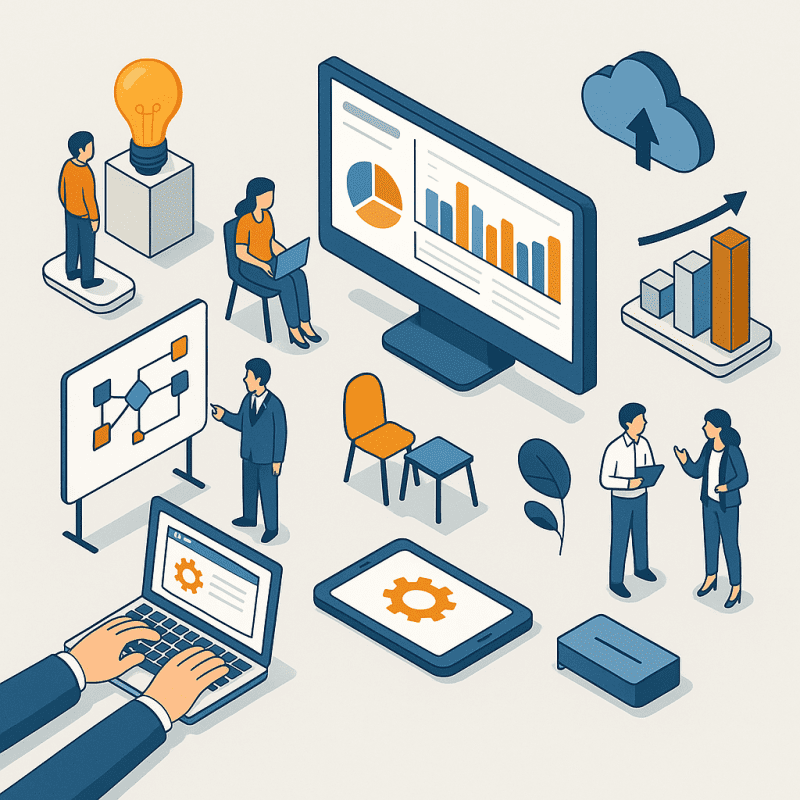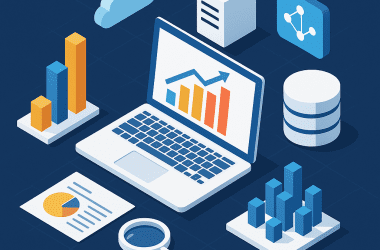Table of Contents Show
The phrase “digital transformation” has lost its meaning. It used to spark boardroom excitement and earn consultancy firms millions. Now, it’s the eye-roll-inducing catchphrase of execs who still think “cloud” is a new thing. The truth? Digital transformation is dead. It’s been dead for a while. And in its place, a more agile, more enduring mindset has emerged – digital thinking.
This isn’t just a rebrand. It’s a philosophical shift. Digital transformation was about tools. Digital thinking is about mindset, adaptability, and behavior. Transformation implies a start and end. Thinking implies a way of being – something permanent, flexible, and embedded in your culture, not your tech stack.
The Rise and Fall of Digital Transformation
At its core, digital transformation was supposed to help companies adapt to technological change – whether by moving infrastructure to the cloud, introducing mobile apps, automating customer service, or digitizing paper trails. And for a while, it worked. Or at least looked like it did.
Around 2010 to 2020, transformation programs exploded. Big consulting firms cashed in. Budgets ballooned. Legacy systems were retired. CEOs gave TED-style talks about being “digital-first.” But the problem? Transformation became a one-time event. A project. Something you did and then ticked off.
Many organizations didn’t evolve past this mindset. They digitized the past, rather than designing for the future.
Here’s a common pattern:
| Phase | What Actually Happened |
|---|---|
| Buy digital tools | Shiny tech bought with no clear usage strategy |
| Hire a Chief Digital Officer | Marginalized by legacy-minded leadership |
| Launch app/portal | Poor user adoption; no ongoing updates |
| Declare success | Declared prematurely; culture remains unchanged |
In short: you can’t transform if you don’t think differently. You can’t layer tech onto old thinking and expect results.
Digital Thinking: A Permanent Operating Model
Digital thinking is not a project. It’s how modern businesses operate.
It’s a mindset that constantly asks:
- What is the simplest, fastest way to solve this with technology?
- How do we design systems that learn, adapt, and improve?
- Are we empowering the right people to make decisions?
- Is our value to the customer increasing or stagnating?
Let’s contrast the two:
| Digital Transformation | Digital Thinking |
|---|---|
| One-off initiative | Ongoing mindset |
| IT-led | Cross-functional |
| Ends when tech is deployed | Never ends |
| Focus on technology | Focus on people, data, agility |
| Top-down change | Distributed ownership |
Digital thinking absorbs failure, adapts quickly, and doesn’t need a crisis to evolve. It’s not about implementing Microsoft Teams; it’s about rethinking how work gets done.
The Pandemic Was the Final Nail
COVID-19 didn’t kill digital transformation – but it exposed it. Businesses that had already embraced digital thinking pivoted fast. Others scrambled.
Some restaurants turned on a dime to delivery apps. Others died clinging to fax machines. Remote work was forced on laggards and embraced by nimble players.
Here’s the blunt reality: if your “transformation” wasn’t already done by March 2020, it failed. What mattered in that moment wasn’t what you had digitized – it was how you thought.
From Silos to Systems
One of the biggest challenges in transformation efforts was silos. IT didn’t talk to marketing. Finance didn’t talk to operations. Tools were implemented by department, not use case. Data didn’t flow.
Digital thinking breaks down these barriers. It sees the organization as an ecosystem, not a hierarchy. It respects the value of user journeys, process interdependencies, and feedback loops. It treats employees and customers as co-creators, not just endpoints in a pipeline.
One powerful shift: digital thinkers move from “projects” to products. They stop asking “What’s the deliverable?” and start asking, “How do we keep this valuable over time?”
You Don’t Need Transformation. You Need Culture Change.
Ask any digital veteran what the biggest barrier is, and they won’t say “lack of tools.” They’ll say culture. Legacy thinking. Risk aversion. Bureaucracy.
Here are the signs you need digital thinking, not more transformation:
- People hoard data instead of sharing insights.
- Decisions take weeks and pass through endless committees.
- Failure is punished, so no one takes risks.
- New tools gather dust because no one was trained or empowered to use them.
If that’s your workplace, you don’t need another app – you need a mindset reboot.
Digital Thinking Demands Digital Leadership
Not digital dictatorship. Leadership in this era means:
- Empowering teams with autonomy and clear goals.
- Modeling adaptability, not just demanding it.
- Prioritizing learning over perfection.
- Rewarding curiosity, not control.
Many execs still equate digital leadership with knowing jargon or hiring the right vendors. But digital thinking leadersask better questions, tolerate ambiguity, and obsess over customer and employee experience, not shiny dashboards.
If you’re stuck in a transformation mindset, leadership becomes about compliance and control. But in digital thinking, leadership is about alignment and trust.
Case Study Snapshots
Let’s look at a few real-world examples – some who got it, some who didn’t.
1. Netflix vs. Blockbuster
Blockbuster digitized late – adding DVD-by-mail too late, and launching clunky streaming tech. Netflix didn’t just digitize video rentals – it reimagined entertainment distribution. Then it evolved into a content creator using real-time viewing data.
2. Shopify vs. traditional retailers
While legacy retailers spent years building omnichannel platforms, Shopify enabled small businesses to go online in a day. It removed friction and made tech serve people, not the other way around.
3. Zoom vs. enterprise collaboration suites
Zoom didn’t transform meetings. It simplified them. It worked. It scaled. It stayed out of the way. Enterprises with complex transformation roadmaps were still onboarding users to clunky portals while Zoom took over the world.
The Digital Thinker’s Toolbox
Digital thinking doesn’t mean ditching tools – but it does mean rethinking how you use them.
| Tool/Method | Digital Thinking Approach |
|---|---|
| Agile methodology | Continuous learning, not rigid sprint cycles |
| Data analytics | Empowering decisions at every level, not just exec dashboards |
| Cloud infrastructure | Scale and speed as defaults, not luxury |
| AI & automation | Focus on removing friction, not headcount |
| UX/UI design | Treat user experience as strategy, not decoration |
| No-code platforms | Enable business users, not just IT teams |
Tools evolve. Thinking endures.
What Happens If You Don’t Evolve?
Let’s be clear. If you’re still running on the old transformation mindset, you’re in trouble.
- You’ll fall behind on customer expectations.
- You’ll become slower than your competitors.
- Your best talent will leave. (Digital thinkers don’t tolerate bureaucratic decay.)
- You’ll burn money on tools no one uses.
- You’ll lose relevance.
And if you think your industry is the exception – banking, government, healthcare – you’re wrong. In fact, those are the sectors most at risk of becoming obsolete without a rethink.
Digital Thinking Is Business Thinking
This isn’t a tech conversation anymore. This is business survival.
In fact, we should stop separating “digital” from “business.” The two are inseparable now. If you’re not digitally fluent as a leader, you’re not fluent. Full stop.
According to Investopedia, digital transformation should lead to greater efficiency, new value creation, and customer experience gains. But digital thinking goes further. It questions the assumptions behind what “value” means. It forces continuous alignment with what people actually want.
And that’s not something you roll out with a Gantt chart and a million-dollar consultant. That’s something you live, breathe, and build into your culture.
The Future of Work Is a Digital Mindset
What will define winners and losers in the next decade?
- It won’t be who has the best app.
- It won’t be who buys the latest AI tool.
- It won’t be who builds the biggest tech team.
It will be who learns fastest, adapts best, and thinks differently.
Digital thinking will be essential in:
- Hiring and onboarding – removing friction and bias.
- Customer service – leveraging automation without losing empathy.
- Product development – iterative, user-driven, always improving.
- Sales – where personalization and data fluency are non-negotiable.
- Leadership – which must balance performance with psychological safety.
If your workplace feels stuck, start here: rebuild how people think, not just what they do.
Practical Steps to Shift From Transformation to Thinking
- Kill your digital transformation roadmap.
Start with value mapping instead. What are you doing that actually improves life for customers or staff? - Start with people, not tech.
Interview users. Watch them. Find their pain. Then fix it fast. - Build cross-functional squads.
Digital thinking demands collaboration between product, tech, ops, and design. - Reward experimentation.
Let people try, test, and learn. Make failure cheap and recovery fast. - Decentralize decision-making.
Push authority down. Trust your teams to solve problems creatively. - Celebrate agility, not planning.
Plans are guesses. Learn by doing, not predicting.
Final Thought: This Is Not Optional
Still skeptical? Look at how many industries were completely disrupted by players who thought differently. From taxis to hotels, music to banking – those who clung to their “transformation plans” lost to those who reimagined the rules.
“Digital transformation” was a useful idea – for a time. But digital thinking is the future.
Stop transforming. Start thinking.








